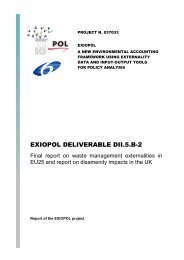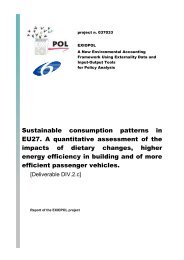Gulf and European Energy Supply Security - Feem-project.net
Gulf and European Energy Supply Security - Feem-project.net
Gulf and European Energy Supply Security - Feem-project.net
You also want an ePaper? Increase the reach of your titles
YUMPU automatically turns print PDFs into web optimized ePapers that Google loves.
onshore (378 TWh/yr), large-scale hydro (320 TWh/<br />
yr), solid biomass (128 TWh/yr), biogas (78 TWh/yr),<br />
small hydro (55 TWh/yr) will contribute about 83.7<br />
percent to RES-E production. In contrast, novel RES-<br />
E options with huge future potentials such as PV (60<br />
TWh/yr), solar thermal electricity (113 TWh/yr) or<br />
tidal & wave energy (35 TWh/yr) <strong>and</strong> wind offshore<br />
(33 TWh/yr) enter the market <strong>and</strong> achieve a steadily<br />
growing share. However, remarkable contributions<br />
can, under a Business as Usual scenario, only be<br />
expected in the period beyond 2020. Generally,<br />
current support measures lead to an increased share<br />
of RES-E generation, but mainly driven by already<br />
experienced technologies, whereas the development<br />
of novel technologies is strongly limited, also caused<br />
by existing non-economic barriers.<br />
In contrast to the electricity sector, the renewable<br />
heat sector is under Business as Usual circumstances<br />
also strongly dominated by already well established<br />
energy technologies, where, as already mentioned,<br />
Overview of RES Characteristics <strong>and</strong> Future Scenarios<br />
the biggest RES share is achieved in the individual,<br />
non-grid heat sector. Here solid biomass generated<br />
about 50 Mtoe in 2006 but only grows to 54 Mtoe in<br />
2030, whereas novel technologies like heat pumps<br />
(2.3 Mtoe) <strong>and</strong> solar thermal heat <strong>and</strong> water (3.4<br />
Mtoe) show bigger growth rates. Nevertheless,<br />
biomass plays a crucial role in the heat sector <strong>and</strong>,<br />
besides in the individual heating plants, is also often<br />
used in co-firing plants. With respect to the overall<br />
Table 1: Share of Renewable Energies in Electricity, Heat <strong>and</strong> Transport Fuel Dem<strong>and</strong><br />
t<br />
u<br />
p<br />
t<br />
u<br />
o<br />
y<br />
g<br />
r<br />
e<br />
n<br />
e<br />
-<br />
E<br />
-<br />
S<br />
E<br />
R<br />
]<br />
r<br />
a<br />
e<br />
y<br />
/<br />
h<br />
W<br />
T<br />
[<br />
% deployment 2006 2010<br />
<strong>European</strong> Union 27<br />
2020 2030<br />
Share of RES-E on electricity dem<strong>and</strong> 16% 20% 35% 50%<br />
Share of RES-H on heat dem<strong>and</strong> 10% 12% 20% 31%<br />
Share of RES-T on transport fuel dem<strong>and</strong> 1% 2% 8% 10%<br />
Share of RES on final dem<strong>and</strong> 9% 11% 20% 30%<br />
Share of RES on primary dem<strong>and</strong> 7% 9% 18% 26% (Eurostat convention)<br />
10% 13% 23% 35% (Substitution principle)<br />
1.400<br />
1.200<br />
1.000<br />
800<br />
600<br />
400<br />
200<br />
0<br />
2006 2010 2015 2020 2025 2030<br />
target achievement of 20 percent RES by 2020,<br />
which has failed under Business as Usual, it must<br />
be concluded that strong efforts have to be made<br />
in the heat sector to achieve a much higher growth<br />
rate than the 8.5 percent increase seen in Figure 5.<br />
Finally, the development of the renewable<br />
transport sector according to the Business as Usual<br />
scenario is given in Figure 6. Traditional biofuel<br />
generation triples beyond 2010 from 3 Mtoe as of<br />
2006 to 9 Mtoe by 2030. Additional contribution is<br />
expected from advanced biofuel generation (second<br />
Figure 4: Future Renewable <strong>Energy</strong> Generation within the Electricity Sector in the <strong>European</strong><br />
Union up to 2030 on Technology Level according to the Muddling Through Scenario<br />
Wind offshore<br />
Wind onshore<br />
Tide & wave<br />
Solar thermal electricity<br />
Photovoltaics<br />
Hydro large-scale<br />
Hydro small-scale<br />
Geothermal electricity<br />
Biowaste<br />
Solid biomass<br />
Biogas
















